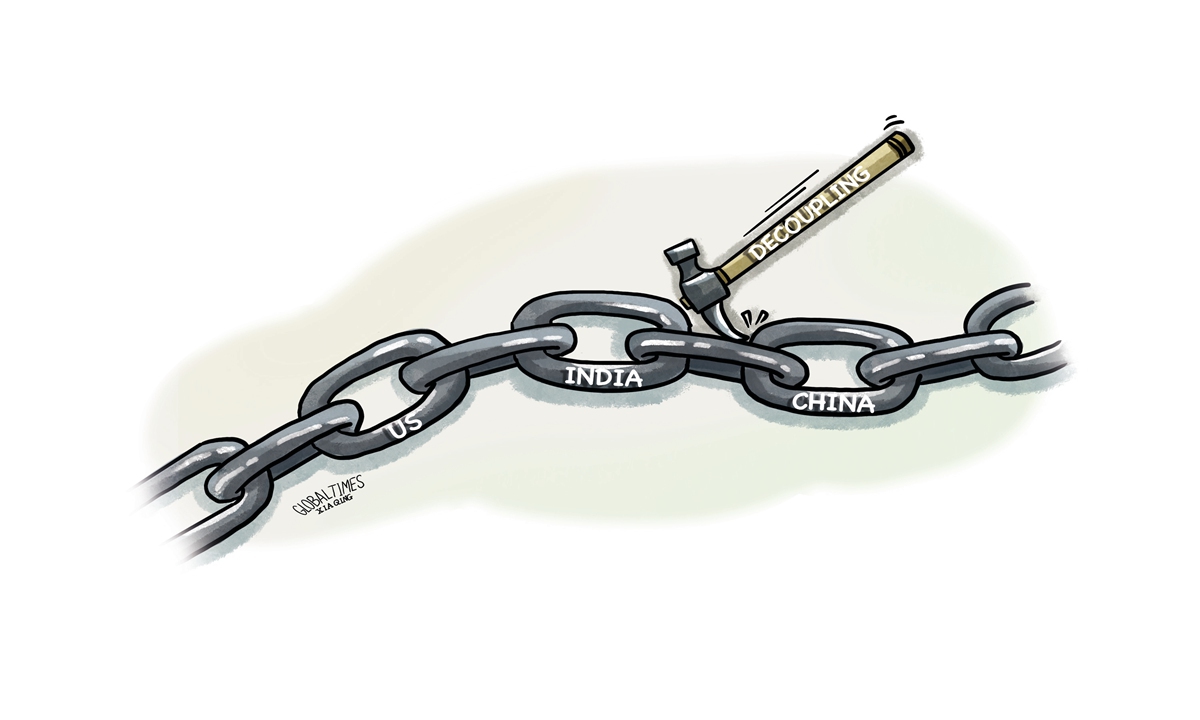
Illustration: Chen Xia/Global Times
For a long time, Western media outlets have repeatedly portrayed India as an "alternative" to China in terms of trade and manufacturing in their narratives serving the wrong "decoupling" approach. However, these misleading reports are not conducive but detrimental to the development of the Indian economy, infrastructure, and manufacturing.
In a report entitled "Global trade needs a China alternative. India needs better ports," the New York Times said that by the standards of the world's largest ports - many of them in China - India's biggest cargo port Jawaharlal Nehru Port remains a small operation. India needs better ports while expanding existing docks to support its manufacturing and export ambitions.
While enhancing infrastructure is crucial for India's manufacturing and trade ambitions, the West's portrayal of India as an "alternative'"to China could hinder rather than help its development, as such narratives only serve the West's geopolitical calculations, not caring about India's interests and benefits.
In fact, the industrial chain and trade cooperation between China and India continues to strengthen, despite geopolitical interference. It is important to note that in terms of trade and manufacturing, it is not a question of one country replacing the other. The notion of promoting India as an "alternative" to China is a fallacy that lacks logical reasoning.
Currently, pragmatic voices from New Delhi have recognized the importance of leveraging the vast potential for economic, trade, and industrial collaboration with China. China's advanced manufacturing technologies and its exports of machinery equipment, intermediate products, and essential components are becoming increasingly vital for India's manufacturing and economic goals.
India's imports from China across at least 25 major commodity groups such as consumer electronics, auto components, and iron and steel products rose in fiscal year 2022-23, which runs from April 2022 to March 2023. China has become India's largest trading partner again in fiscal year 2023-24, according to media reports.
Moreover, the development of a strong manufacturing industry and exports in India requires more than just "building better ports." Port construction is just a link in the infrastructures chain which also includes highways, high-speed rail and airports. More importantly, India needs to ramp up efforts to connect with the regional transportation network with China as an important link.
The challenges impeding the growth of the Indian infrastructure and logistics industry have been longstanding. India's development cannot be separated from the development of infrastructure and logistics industry, otherwise the further development of the Indian economy will be constrained.
There are many issues in the development of India's infrastructure and logistics industry, including its road transportation, power transmission, and others. To solve these problems, it requires large investment, long-term and persistent investment, as well as political will and top-down execution.
In addition of "hard connectivity," India also needs to improve its "soft connectivity," that is, institutional openness to the outside world, free trade agreements, reducing tariffs and non-tariff barriers, in order to promote the import and export of manufacturing industry.
In terms of infrastructure development, it is no secret that when the Belt and Road Initiative and other regional cooperation initiatives are providing tangible benefits to regions around the world, most of the infrastructure and trade plans proposed by the US with geopolitical calculations often fall short of their promises in terms of input.
For India, it is more critical to develop its manufacturing industry and infrastructure by steering clear of US geopolitical interference and avoiding the trap of "alternative" narratives. Choosing to embrace the existing industrial chains and trade cooperation in the Asia-Pacific region is clearly in line with economic and market rules and is a beneficial approach.
The author is a reporter with the Global Times. bizopinion@globaltimes.com.cn




